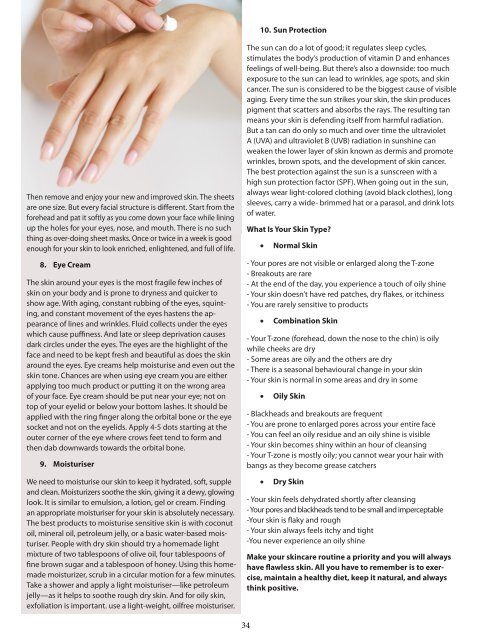You also want an ePaper? Increase the reach of your titles
YUMPU automatically turns print PDFs into web optimized ePapers that Google loves.
10. Sun Protection<br />
Then remove <strong>and</strong> enjoy your new <strong>and</strong> improved skin. The sheets<br />
are one size. But every facial structure is different. Start from the<br />
forehead <strong>and</strong> pat it softly as you come down your face while lining<br />
up the holes for your eyes, nose, <strong>and</strong> mouth. There is no such<br />
thing as over-doing sheet masks. Once or twice in a week is good<br />
enough for your skin to look enriched, enlightened, <strong>and</strong> full of life.<br />
8. Eye Cream<br />
The skin around your eyes is the most fragile few inches of<br />
skin on your body <strong>and</strong> is prone to dryness <strong>and</strong> quicker to<br />
show age. With aging, constant rubbing of the eyes, squinting,<br />
<strong>and</strong> constant movement of the eyes hastens the appearance<br />
of lines <strong>and</strong> wrinkles. Fluid collects under the eyes<br />
which cause puffiness. And late or sleep deprivation causes<br />
dark circles under the eyes. The eyes are the highlight of the<br />
face <strong>and</strong> need to be kept fresh <strong>and</strong> beautiful as does the skin<br />
around the eyes. Eye creams help moisturise <strong>and</strong> even out the<br />
skin tone. Chances are when using eye cream you are either<br />
applying too much product or putting it on the wrong area<br />
of your face. Eye cream should be put near your eye; not on<br />
top of your eyelid or below your bottom lashes. It should be<br />
applied with the ring finger along the orbital bone or the eye<br />
socket <strong>and</strong> not on the eyelids. Apply 4-5 dots starting at the<br />
outer corner of the eye where crows feet tend to form <strong>and</strong><br />
then dab downwards towards the orbital bone.<br />
9. Moisturiser<br />
We need to moisturise our skin to keep it hydrated, soft, supple<br />
<strong>and</strong> clean. Moisturizers soothe the skin, giving it a dewy, glowing<br />
look. It is similar to emulsion, a lotion, gel or cream. Finding<br />
an appropriate moisturiser for your skin is absolutely necessary.<br />
The best products to moisturise sensitive skin is with coconut<br />
oil, mineral oil, petroleum jelly, or a basic water-based moisturiser.<br />
People with dry skin should try a homemade light<br />
mixture of two tablespoons of olive oil, four tablespoons of<br />
fine brown sugar <strong>and</strong> a tablespoon of honey. Using this homemade<br />
moisturizer, scrub in a circular motion for a few minutes.<br />
Take a shower <strong>and</strong> apply a light moisturiser—like petroleum<br />
jelly—as it helps to soothe rough dry skin. And for oily skin,<br />
exfoliation is important. use a light-weight, oilfree moisturiser.<br />
The sun can do a lot of good; it regulates sleep cycles,<br />
stimulates the body’s production of vitamin D <strong>and</strong> enhances<br />
feelings of well-being. But there’s also a downside: too much<br />
exposure to the sun can lead to wrinkles, age spots, <strong>and</strong> skin<br />
cancer. The sun is considered to be the biggest cause of visible<br />
aging. Every time the sun strikes your skin, the skin produces<br />
pigment that scatters <strong>and</strong> absorbs the rays. The resulting tan<br />
means your skin is defending itself from harmful radiation.<br />
But a tan can do only so much <strong>and</strong> over time the ultraviolet<br />
A (UVA) <strong>and</strong> ultraviolet B (UVB) radiation in sunshine can<br />
weaken the lower layer of skin known as dermis <strong>and</strong> promote<br />
wrinkles, brown spots, <strong>and</strong> the development of skin cancer.<br />
The best protection against the sun is a sunscreen with a<br />
high sun protection factor (SPF). When going out in the sun,<br />
always wear light-colored clothing (avoid black clothes), long<br />
sleeves, carry a wide- brimmed hat or a parasol, <strong>and</strong> drink lots<br />
of water.<br />
What Is Your Skin Type?<br />
• Normal Skin<br />
- Your pores are not visible or enlarged along the T-zone<br />
- Breakouts are rare<br />
- At the end of the day, you experience a touch of oily shine<br />
- Your skin doesn’t have red patches, dry flakes, or itchiness<br />
- You are rarely sensitive to products<br />
• Combination Skin<br />
- Your T-zone (forehead, down the nose to the chin) is oily<br />
while cheeks are dry<br />
- Some areas are oily <strong>and</strong> the others are dry<br />
- There is a seasonal behavioural change in your skin<br />
- Your skin is normal in some areas <strong>and</strong> dry in some<br />
• Oily Skin<br />
- Blackheads <strong>and</strong> breakouts are frequent<br />
- You are prone to enlarged pores across your entire face<br />
- You can feel an oily residue <strong>and</strong> an oily shine is visible<br />
- Your skin becomes shiny within an hour of cleansing<br />
- Your T-zone is mostly oily; you cannot wear your hair with<br />
bangs as they become grease catchers<br />
• Dry Skin<br />
- Your skin feels dehydrated shortly after cleansing<br />
- Your pores <strong>and</strong> blackheads tend to be small <strong>and</strong> imperceptable<br />
-Your skin is flaky <strong>and</strong> rough<br />
- Your skin always feels itchy <strong>and</strong> tight<br />
-You never experience an oily shine<br />
Make your skincare routine a priority <strong>and</strong> you will always<br />
have flawless skin. All you have to remember is to exercise,<br />
maintain a healthy diet, keep it natural, <strong>and</strong> always<br />
think positive.<br />
34


